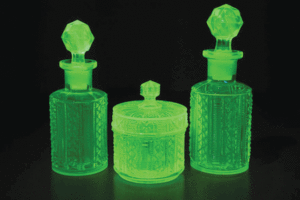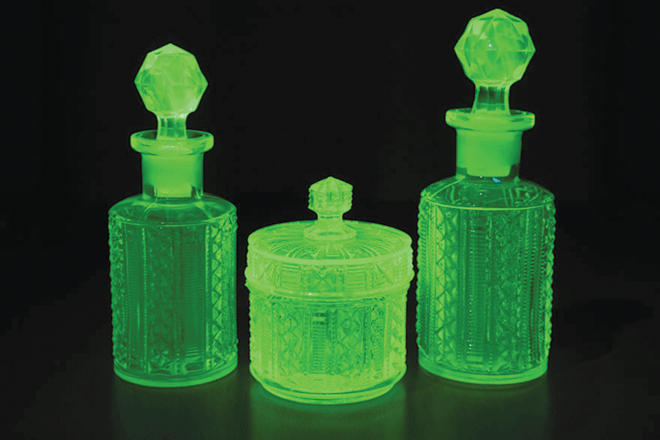
Glassware is a great antique to investigate under a blacklight because glass, such as the Vaseline glass shown above, will glow under an ultraviolet light because of the uranium oxide content in the glass.
Ultraviolet light, or UV, also known as “black lights” are used to evaluate the hidden world of antiques.
Materials fluoresce under UV lighting, producing light that the human eye cannot see, making the unseen seen.
One can tell age, repairs jobs, authenticity and fakes using this technique. Wavelengths of light can all be seeing using modern tools in the antique world.
Black lights fluoresce using light wave lengths, or energy if you will.
Materials in the antiques you are examining react in different ways when hit with the waves.
Sometimes the energy makes glow, and other times they appear black, depending upon whether they are absorbing energy or reflecting it.
A good rule of thumb to investigate is whether or not areas look different in appearance-as if something has been changed from the original structure.
This will be your clue that a repair or other things have been done to the item.
It is best to investigate your item in a dimly lit or completely black room, so as not to compete with the light waves from the outside world.
Glassware is a great antique to investigate under a blacklight because glass like Vaseline glass will glow under a UV light due to the uranium oxide content in the glass.
Oxides in older glass will fluoresce under different conditions, usually glowing yellow.
Glass to investigate would be Depression glass, American pressed glass, brilliant cut glass and any older piece.
One of the most shocking and magnificent reactions to UV light can be found in Uranium glass due to the oxide/uranium content in the glass-it glows a brilliant green yellow, and some cabinets are made specifically to use black lights to illuminate, showing off a “glowing” collection.
Fabrics are a good thing to test under a black light.
Fibers like polyester and rayon, which are modern fibers made after World War II, will fluoresce under a UV light, showing the age of the piece.
Collectors should use caution when using modern laundry detergents, as they will cause fabrics to glow due to the chemical content in the washing liquids.
Fabric research is more investigation of modern fibers and materials rather than determining the older materials and their presence.
Porcelain can be investigated using a black light.
Hard paste porcelain will fluoresce a deep blue, while soft past procelain will fluoresce white.
One can easily determine repairs jobs, as modern glue and chemicals glow under a black light, as well as later additions of embellishment to a piece, cracks and seams.
A darkened room is best to evaluate procelain, as some repairs are very small and might be hard to see in well-lit conditions.
Evaluating paintings is one of the trickiest and complicated forms of UV inspection.
Dealers and collectors are using a black light on paintings to determine age, repairs, repaints, touch-ups, fakes or forgeries, and signatures.
Museums use black lights to inspect very old antiquity for master works and their concepts and repaints. In the antiques world, more modern paint glows under a light, and one can also see touch-ups, repairs and cracks in structure.
Often times one must clean a painting before a true UV inspection can happen, as dirt and soot from years of fireplace smoke, house grime, storing and filth can mount and collect on the surface of a painting, especially oil, and block the waves of the UV light you are using.
Most people use professionals to evaluate paintings, especially oil, as experts know exactly what to look for when dealing with the layers of time and repairs in a painting.
Ephemera, or things such as old postcards, signs, books, canned food labels or other vintage paper products rarely glow.
The chemicals, bleach and dyes in modern printing techniques do glow, and it is easy to determine what is going on with your ephemera using a hand held black light.
Paper items before 1930 will not glow, as the dyes and techniques were much different back in manufacturing processes in those times.
Often times items such as painted cast iron, painted or pieced together furniture, old hardware, architectural elements and other antique items can be evaluated using a black light for age, forgery, materials and more because most modern paints and products use chemicals that glow under a black light.
Products like polymeres, bleach, additives of a chemical nature and colorants often glow when made or manufactured in modern times.
Glowing doesn’t always mean new, as with old glass products, so other research is needed to determine where the item came from originally, the story behind the item, any paperwork trail or history, and the region from which it came.
Modern tools such as the UV or black light have revolutionized the way antique dealers and collectors can investigate, and ultimately conclude information about their valued treasures and investments.
Determining age, condition, repairs, forgery and stories about an item goes a long way in the world of antiques for obtaining top dollar, confidence in clarity, and sound investments for tangible goods. It is a fun way to play antique detective if a piece or collection needs investigation.
(Editor’s note: DeeDee Wood is the store manager at Tharpe Antiques, in Easton, part of the Talbot Historical Society.)




